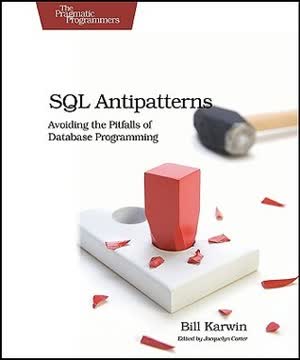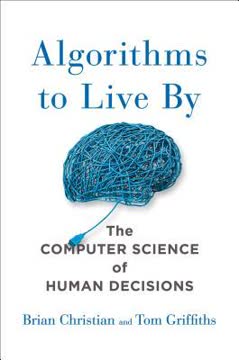Key Takeaways
1. SQL Antipatterns: Common Mistakes to Avoid in Database Design
If you break the relationship between the data and the database, then you take on the burden of managing that data yourself.
Recognizing antipatterns: SQL antipatterns are common but problematic solutions to database design challenges. They often arise from misunderstandings about relational database principles or attempts to simplify complex data relationships.
Common antipatterns include:
- Storing multiple values in a single column (e.g., comma-separated lists)
- Using generic attribute tables instead of proper normalization
- Ignoring the importance of foreign key constraints
- Overusing FLOAT data types for precise numeric values
By recognizing these antipatterns, developers can avoid pitfalls that lead to data inconsistency, poor performance, and difficult-to-maintain code.
2. Logical Database Design: Structuring Data Relationships Effectively
Model both of these in a way that supports the queries you need to make against the hierarchy.
Normalization and relationships: Proper logical database design involves structuring data to minimize redundancy and ensure data integrity. This includes normalizing tables and establishing appropriate relationships between entities.
Key aspects of logical design:
- Identifying entities and their attributes
- Establishing primary and foreign keys
- Determining cardinality of relationships (one-to-one, one-to-many, many-to-many)
- Implementing junction tables for many-to-many relationships
Effective logical design supports efficient querying and data manipulation while maintaining data consistency across the database.
3. Physical Database Design: Optimizing Storage and Performance
If you can read passwords, so can a hacker.
Optimizing for efficiency: Physical database design focuses on how data is actually stored and accessed. This involves choosing appropriate data types, indexing strategies, and storage structures to optimize performance and security.
Important considerations:
- Selecting the right data types (e.g., NUMERIC for precise calculations instead of FLOAT)
- Implementing indexes strategically to improve query performance
- Using appropriate storage engines based on data access patterns
- Securing sensitive data through encryption or hashing
Proper physical design ensures that the database can handle the required workload efficiently and securely.
4. Query Antipatterns: Writing Efficient and Accurate SQL
SQL treats a column as an atomic value. If you need to optimize searching for a substring, then you need to use an extension to SQL or a complementary technology.
Avoiding common pitfalls: Query antipatterns often result from misunderstanding SQL's capabilities or attempting to force relational databases to behave like non-relational systems.
Examples of query antipatterns:
- Using subqueries where joins would be more efficient
- Relying on implicit type conversion instead of explicit casting
- Overusing wildcard (*) in SELECT statements
- Neglecting to use appropriate indexing for frequently queried columns
By understanding these antipatterns, developers can write more efficient and maintainable SQL queries.
5. Application Development: Integrating SQL with Best Practices
Use software development best practices, including documentation, testing, and version control, for your database as you do for your application code.
Treating database code as first-class: Database code should be subject to the same software engineering practices as application code. This includes version control, testing, and documentation.
Best practices for database development:
- Using database migrations for schema changes
- Implementing automated testing for database queries and procedures
- Documenting database schema, relationships, and key queries
- Applying code review processes to database changes
Integrating these practices ensures that database development is aligned with overall software development processes and quality standards.
6. Security and Data Integrity: Protecting Your Database
Let users input values, but never let users input code.
Implementing robust safeguards: Database security and data integrity are critical aspects of database design and management. This involves protecting against unauthorized access, data corruption, and SQL injection attacks.
Key security measures:
- Implementing proper authentication and authorization mechanisms
- Using prepared statements to prevent SQL injection
- Encrypting sensitive data at rest and in transit
- Regularly auditing and monitoring database access and changes
Maintaining data integrity through constraints, triggers, and validation ensures the accuracy and reliability of stored information.
7. Evolving Database Design: Adapting to Changing Requirements
Don't let data spawn metadata.
Flexible yet structured design: Database designs must evolve to meet changing business requirements while maintaining data integrity and performance. This involves strategies for handling schema changes and data migrations.
Approaches to evolving design:
- Using flexible schema designs (e.g., EAV model) judiciously
- Implementing versioning strategies for schema changes
- Planning for data migration and transformation
- Balancing between normalization and denormalization based on evolving needs
A well-designed database should be able to accommodate change without requiring a complete overhaul of the existing structure.
Copyright © 2022, The Pragmatic Bookshelf.
Last updated:
FAQ
1. What is SQL Antipatterns: Avoiding the Pitfalls of Database Programming by Bill Karwin about?
- Focus on common mistakes: The book explores frequent errors and bad practices in SQL database programming, aiming to help developers recognize and avoid these pitfalls.
- Comprehensive coverage: It addresses issues in logical and physical database design, query writing, and application integration with SQL.
- Practical, example-driven approach: Bill Karwin uses real-world scenarios and a hypothetical bug-tracking database to illustrate antipatterns and their solutions.
- Goal of the book: The main objective is to help readers write more reliable, maintainable, and efficient SQL code by understanding why certain patterns are problematic.
2. Why should I read SQL Antipatterns by Bill Karwin?
- Learn from others’ mistakes: The book reveals common errors that even experienced developers make, helping you avoid bugs, security vulnerabilities, and performance issues.
- Applicable to all skill levels: Whether you’re a beginner or a seasoned professional, the book offers insights that reinforce good practices and dispel widespread misconceptions.
- Improve collaboration: By explaining the consequences of poor SQL practices, it helps bridge the gap between developers and DBAs, fostering better teamwork.
- Enhance application reliability: Following the advice reduces risks like SQL injection, data inconsistencies, and maintenance headaches.
3. What are the key takeaways and main categories of SQL antipatterns in SQL Antipatterns by Bill Karwin?
- Four main categories: The book covers Logical Database Design, Physical Database Design, Query Antipatterns, and Application Development Antipatterns.
- Learn to spot pitfalls: Readers learn to identify and correct common mistakes in schema design, query writing, and application integration.
- Emphasis on practical solutions: Each antipattern is paired with recommended best practices and alternative approaches.
- Improved database skills: The book aims to make readers more proficient in writing clear, efficient, and secure SQL.
4. What are the best quotes from SQL Antipatterns by Bill Karwin and what do they mean?
- “An expert is a person who has made all the mistakes that can be made in a very narrow field.” This quote highlights the value of learning from mistakes, both your own and others’.
- “One size does not fit all.” Refers to the importance of context in database design, especially regarding primary key conventions.
- “Avoid guessing” (about indexes): Stresses the need for evidence-based decisions when optimizing database performance.
- “Don’t execute unverified input as code.” A reminder of the dangers of SQL injection and the importance of secure coding practices.
5. How does SQL Antipatterns by Bill Karwin address logical database design mistakes like Jaywalking and EAV?
- Jaywalking antipattern: Storing multiple values in a single column (e.g., comma-separated lists) complicates queries and data integrity.
- Recommended fix: Use intersection (join) tables to represent many-to-many relationships, enabling proper foreign key constraints and easier queries.
- EAV (Entity-Attribute-Value) drawbacks: Storing attributes as rows leads to complex queries, poor data integrity, and reporting difficulties.
- Alternatives to EAV: Model subtypes explicitly with inheritance patterns or use semistructured data types like JSON columns when appropriate.
6. What does Bill Karwin recommend for handling hierarchical data in SQL database design?
- Naive tree model limitations: Using a parent_id column makes querying ancestors or descendants complex and inefficient.
- Alternative models: The book presents Recursive Queries (CTEs), Path Enumeration, Nested Sets, and Closure Tables as better options.
- Trade-offs of each model: Nested Sets are efficient for querying but hard to maintain; Closure Tables are versatile but require extra storage.
- Choosing the right model: The best approach depends on your application’s query and update requirements.
7. What are Bill Karwin’s recommendations on primary key conventions and foreign key constraints in SQL Antipatterns?
- Meaningful primary keys: Avoid generic id columns; use descriptive names like bug_id or account_id to clarify relationships.
- Compound and natural keys: Sometimes these are preferable, especially in intersection tables, to prevent duplicates and maintain integrity.
- Importance of foreign keys: Always declare foreign key constraints to enforce referential integrity and automate cascading updates/deletes.
- Avoid manual integrity checks: Relying on application code for data integrity is error-prone and inefficient.
8. How does SQL Antipatterns by Bill Karwin explain and address query antipatterns such as ambiguous GROUP BY, random selection, and full-text search?
- Ambiguous GROUP BY: Referencing nongrouped columns in aggregation queries leads to errors or unreliable results; use window functions or subqueries for clarity.
- Random row selection: ORDER BY RAND() is inefficient; instead, select random keys or use database-specific sampling features.
- Full-text search: LIKE and regex are slow; use vendor-specific full-text indexes or external search engines for better performance.
- Pattern matching alternatives: Build inverted indexes or use third-party tools if built-in full-text search isn’t available.
9. What advice does Bill Karwin give in SQL Antipatterns for handling NULL values and grouping queries?
- Use COALESCE for nulls: Substitute nulls with default values to prevent unexpected null propagation in expressions.
- Beware of NOT IN (NULL): Understand SQL’s three-valued logic to avoid confusing query results.
- Single-Value Rule in GROUP BY: Every column in a GROUP BY query must have a single value per group, enforced by aggregate functions or inclusion in the GROUP BY clause.
- Use standard functions: Prefer standard SQL functions like COALESCE for portability and clarity.
10. What security pitfalls and solutions regarding passwords and SQL injection does SQL Antipatterns by Bill Karwin highlight?
- Plain-text password storage: Storing passwords in plain text is a critical security flaw; always use salted cryptographic hashes.
- Password reset best practices: Avoid sending passwords by email; use temporary tokens and force users to set new passwords securely.
- Preventing SQL injection: Never interpolate user input directly into SQL; use prepared statements with parameter placeholders.
- Input validation: Filter and validate all user input, and use proper escaping for dynamic SQL parts that can’t be parameterized.
11. What does Bill Karwin recommend for using indexes effectively in SQL Antipatterns?
- Avoid guesswork: Don’t create indexes without understanding query patterns; too many or too few indexes can harm performance.
- MENTOR methodology: Measure, Explain, Nominate, Test, Optimize, and Rebuild indexes to ensure they’re effective.
- Beware of index misuse: Indexes on low-selectivity columns or mismatched expressions are often ineffective.
- Regular maintenance: Rebuild and optimize indexes as part of ongoing database management.
12. What is Bill Karwin’s perspective on stored procedures in modern application development, according to SQL Antipatterns?
- Not always the best choice: Don’t use stored procedures by default; consider their portability, debugging, and deployment challenges.
- Performance considerations: Overusing stored procedures can create bottlenecks by overloading the database server.
- Modern architecture preference: Implement business logic in application code when possible, leveraging modern languages and frameworks.
- Selective use cases: Use stored procedures for privileged operations, reducing network latency for complex tasks, or infrequent administrative jobs.
Review Summary
SQL Antipatterns, Volume 1 is highly praised for its clear explanations of common database design mistakes and solutions. Readers appreciate its practical approach, easy-to-follow format, and real-world examples. Many found it valuable for both beginners and experienced developers, highlighting its usefulness in avoiding pitfalls and improving database design skills. The book's coverage of security issues and application development anti-patterns was also well-received. While some felt certain topics could have been explored more deeply, most reviewers considered it an essential read for anyone working with relational databases.
Similar Books
Download PDF
Download EPUB
.epub digital book format is ideal for reading ebooks on phones, tablets, and e-readers.









